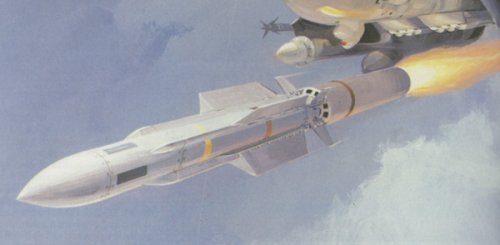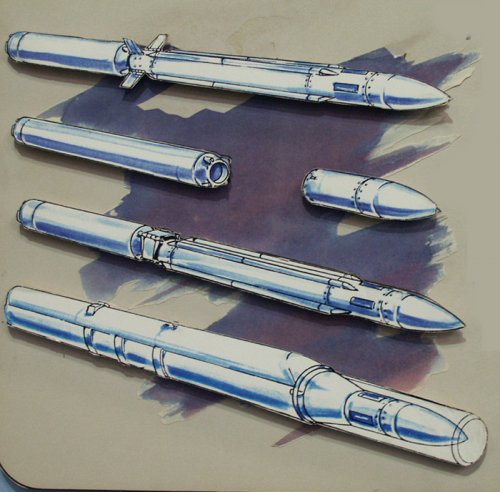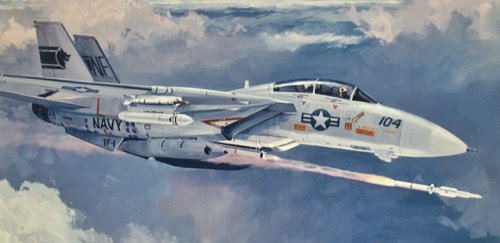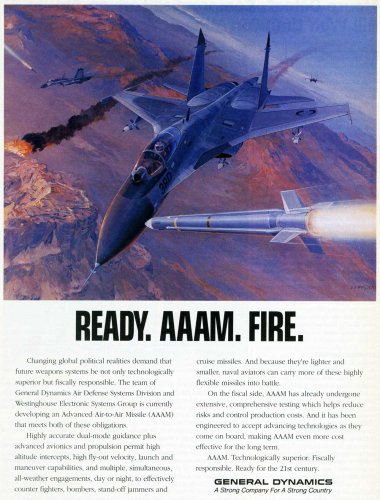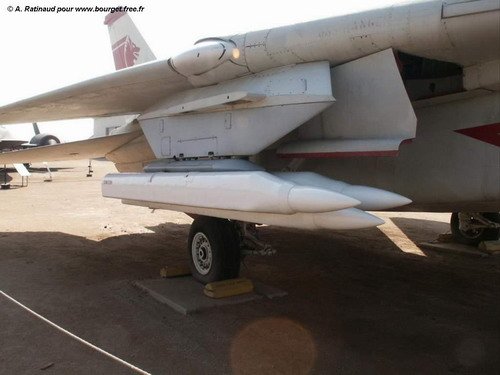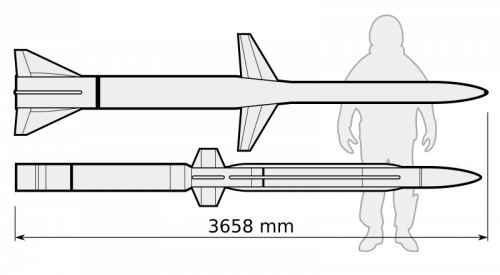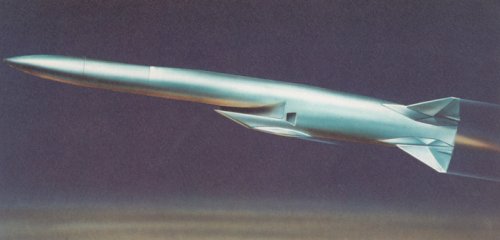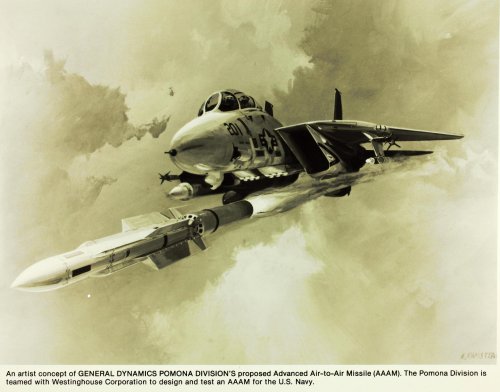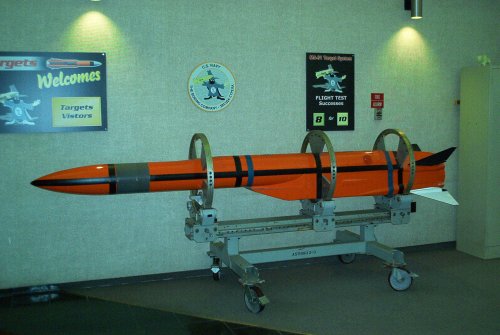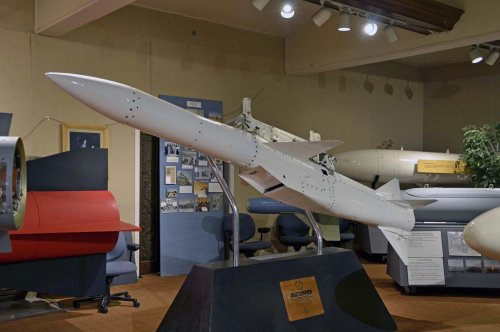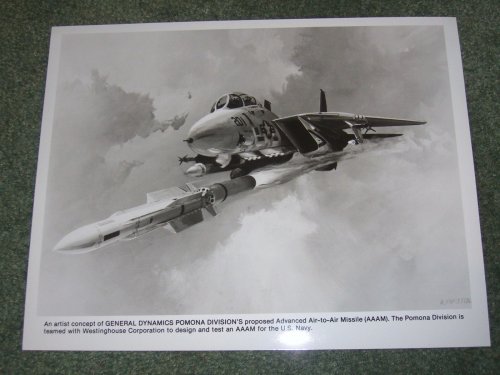efense Contracts: Selected contracts awarded by the Army, Navy and Air Force during the week of April 9-13 are listed here. Contracts already reported by The DAILY and those not related to aerospace are omitted, as are some others, in the interest o NAVY
203 words
18 April 1990
Aerospace Daily
ASD
Pg. 106
Vol. 154, No. 13
English
Copyright 1990 McGraw-Hill, Inc.
March 9, 1990 General Dynamics/Westinghouse AAAM Joint Venture, Pomona, Calif., is being awarded a $9,900,000 increment of funds to a cost-plus-incentive-fee contract -- for the Demonstration and Validation (DEMVAL) phase of the Advanced Air-to-Air Missile (AAAM) Program. This phase of advanced development will include: design and documentation of a baseline system; trade studies and digital simulations; free-flight testing of prototype control test vehicles; hardware-in-the-loop testing of guidance subsystems; captive-carry testing of prototype guidance systems; and comparative testing of prototype guidance systems. Work will be performed in Pomona, Calif. (70%), and Baltimore, Md. (30%), and is expected to be completed in December 1992. Contract funds would not have expired at the end of the current fiscal year. This contract was competitively procured by a Request for Proposal. Two proposals were received.
The Naval Air Systems Command, Washington, D.C., is the contracting activity (N00019-88-C-0151).
Document asd0000020011114dm4i001mb
NAVY EYEING AAAM AS POSSIBLE SPARROW REPLACEMENT
524 words
4 June 1990
Aerospace Daily
ASD
Pg. 371
Vol. 154, No. 45
English
Copyright 1990 McGraw-Hill, Inc.
The in-development Advanced Air-to-Air Missile's performance is expected to be good enough that it could replace some portion of the Navy's AIM-7 Sparrow radar-guided missile inventory, and the concept is being unofficially explored, sources said last week.
If it works as planned, AAAM--slated to replace the AIM-54C Phoenix late this decade--could be more agile than the Advanced Medium-Range Air- to-Air Missile in the latter's envelope, and faster. It would also be "cost-competitive" with AMRAAM, making it an attractive option to replace some Sparrows, one source said. AMRAAM is to replace Sparrow in Air Force and Navy inventories.
The Navy is quietly studying whether to stop buying AMRAAM after the first few hundred are put into fleet service, and applying remaining AMRAAM funds to AAAM. The Navy's requirement for AMRAAM is about 3,500 missiles, which sources said will be reduced in the coming months.
The Navy has no plans "at the present time" to substitute AAAM for any AMRAAMs, a service spokesman said. If the technical promises bear out, the Navy could load AAAM for either medium or long-range missions, with the "necking-down" support savings such a move would entail.
Ongoing studies of post-2000 aircraft carrier employment indicate the Navy will need to intercept aircraft and cruise missiles at greater ranges from a battle group, reducing emphasis on shorter-range weapons. The flexibility of AAAM for medium or long-range missions "fits nicely with what we're finding" about future carrier requirements, a Pentagon official said.
Navy officials are also concerned about continuing quality problems with AMRAAM, full-rate production of which has twice been put off by the Pentagon. One said AAAM's medium-range abilities are "nice to have since we can't be sure what will happen" to AMRAAM.
The fact that AAAM wouldn't enter the inventory until the late 1990s has kept the Navy from bailing out of AMRAAM so far, sources said. "We are already betting that AAAM will come in on time because we are taking a chance on extending Phoenix," funding of which has ended, a Pentagon official said. Relying on AAAM to replace Phoenix and AMRAAM "is just too risky," he said. Sparrow is "not able to deal with the threat as we enter the mid-90s," he reported.
"We need both missiles," a senior Navy official said.
One official noted that "necking-down" savings from buying more AAAMs at the expense of AMRAAM would be negligible since AMRAAM would already be in fleet service and require continuing support.
Two teams are vying to build AAAM: General Dynamics/Westinghouse and Hughes/Raytheon. The GD/Westinghouse AAAM proposal would have a dual-mode RF/infrared seeker, giving it capability as "a beyond-visual-range Sidewinder," one source said. Both versions are to be about the same size as Sparrow, so there would be no load penalty in carrying AAAM instead of AMRAAM.
Congress is favorably impressed with AAAM and has urged the Navy to accelerate the program (DAILY, Aug. 31, 1989).
Document asd0000020011114dm64001l1
SASC WANTS PHOENIX AS HEDGE UNTIL NATF, AAAM AVAILABLE
319 words
24 July 1990
Aerospace Daily
ASD
Pg. 128
Vol. 155, No. 16
English
Copyright 1990 McGraw-Hill, Inc.
The Senate Armed Services Committee authorized funding to upgrade a portion of the fiscal year 1991 Phoenix missile buy to the AIM-54C++ configuration, to keep the missile capable until its successor, the Advanced Air-to-Air Missile, is available, Senate staffers reported.
The improvements will be worked on about 108 missiles to demonstrate the upgrade package, one staffer said. Future improvements are also being considered, he said. Defense Secretary Richard B. Cheney has programmed an end to the Phoenix line in September 1992.
The upgrade package would involve improved electronic counter- countermeasures, a high-power transmitter borrowed from the Advanced Medium-Range Air-to-Air Missile (AMRAAM) and a reprogrammable memory, the staffers said. The improvements would give the missile better acquisition range and angle, improved maneuverability at long ranges and a "three-fold increase in the 'no-escape zone,'" one reported.
The "plus-plus" version would also improve the missile's ability to survive anti-radiation missiles and "next-generation threats," he said.
"It will be 10 years at least before we get AAAM," the staffer said. "The NATF (Naval Advanced Tactical Fighter) has also been slipped," and the Navy will face "tougher targets" in the near future. During that time, the Soviet Union is expected to field at least two large-deck aircraft carriers equipped with Su-27 Flanker and MiG-29 Fulcrum aircraft, so "we can't stand still," he said.
"We have to upgrade the Phoenix because it has...lost a lot of its edge," he said. The current model of the Phoenix, the AIM-54C+, has been in production since 1986.
The SASC is also eyeing an upgrade of "the rest of the (Phoenix) inventory" starting with the FY '92 budget, one staffer reported. It hasn't been resolved yet from what block number the retrofits would be made, he said.
Document asd0000020011114dm7o002gq
GD/WESTINGHOUSE, HUGHES/RAYTHEON GET AAAM DEM/VAL CONTRACTS
128 words
9 October 1990
Aerospace Daily
ASD
Pg. 36
Vol. 156, No. 5
English
Copyright 1990 McGraw-Hill, Inc.
The two industry teams working on the Navy's Advanced Air-to-Air Missile received Naval Air Systems Command contracts Friday for the next phase of demonstration/validation.
General Dynamics/Westinghouse received $11.6 million and Hughes/Raytheon received $12.6 million cost-plus-incentive-fee contracts that add on to four-year, $110 million dem/val contracts awarded in October 1988.
The next phase of dem/val calls for design and documentation of the baseline AAAM system, trade studies and digital simulations, free-flight testing of prototype control test vehicles, hardware-in-the-loop testing of guidance subsystems, and captive-carry testing and comparative testing of prototype guidance systems. The work is to be finished by December 1992.
Document asd0000020011114dma9002kw
WESTINGHOUSE DEMONSTRATES APEX COMPUTER FOR AAAM
248 words
24 October 1990
Aerospace Daily
ASD
Pg. 151
Vol. 156, No. 17
English
Copyright 1990 McGraw-Hill, Inc.
Westinghouse Electronic Systems Group, Baltimore, Md., has demonstrated an Autopilot/Executive (Apex) computer for use on the Navy's Advanced Air-to- Air Missile (AAAM). Apex will execute control and guidance software for the missile airframe.
Westinghouse and General Dynamics, its joint venture partner for AAAM, will integrate the computer, autopilot/guidance software and the prototype missile airframes for the flight test program in 1991. Competing with the GD-Westinghouse team is a team of Hughes and Raytheon. The AAAM is intended to replace the Phoenix missile in the late 1990s.
The demonstration, carried out during a quarterly review of the program by the Navy last May at Westinghouse facilities in Baltimore, was the culmination of a nine-month effort to design, fabricate and test a state-of-the-art Reduced Instruction Set Computer (RISC) which provides 20 VAX Units of Performance (VUPs) in the volume constraint of 60 cubic inches.
Westinghouse said that to meet the constraint, it used a solderless high density packaging approach that allows a two-to-one increase in density through ceramic integrated circuit packages.
In a separate development, Westinghouse Electronic Systems Group received a $40 million contract from Unisys Corp. for production of 180 transmitters for the Next Generation Weather Radar (Nexrad). The transmitters are derived from transmitters used in the Westinghouse ASR-9 airport surveillance radar. Nexrads will be deployed across the U.S. to provide data for early severe storm warning and improved forecasting.
Document asd0000020011114dmao002y2
GD'S AAAM COULD COMPETE WITH ADVANCED VERSION OF AMRAAM
760 words
1 April 1991
Aerospace Daily
ASD
Pg. 4
Vol. 158, No. 1
English
Copyright 1991 McGraw-Hill, Inc.
General Dynamics' Advanced Air-to-Air Missile could be a competitor to the Air Force's Advanced Medium-Range Air-to-Air Missile late in the decade, sources reported.
The GD AAAM, one of two candidates to replace the Phoenix missile beginning around 1998, will likely be cheaper, lighter, faster and more agile than the pre-planned product improvement (P3I) version of AMRAAM, in addition to having far longer range, a source familiar with the program said.
The new missile will enter production around 1998, about the time the P3I AMRAAM will start coming off the line, sources said. Though P3I AMRAAM's production and initial operating capability dates are classified, the service is taking an event-driven, rather than calendar-driven approach to developing it, an AF official said. "It will be produced when it's ready," he said.
Hughes recently received first funding to start the P3I AMRAAM development process. A contractor will be selected to begin a four-year full-scale development program for AAAM in early 1993.
The GD AAAM will have a speed of about Mach 5, more than twice that of AMRAAM. The missile will weigh about 410 pounds, compared to AMRAAM's 500 pounds, though the AAAM requires a launch tube which weighs 80-100 pounds. The AAAM is to have a range "two to three times" that required of the Phoenix, putting it well over 150 miles, while AMRAAM is intended for targets at 50 miles or less.
In addition, the GD AAAM has a dual-mode seeker, using radar in mid- course and infrared in terminal homing, making it difficult to spoof. AMRAAM has only a radar seeker. AAAM will also have capability in both the X- and K-radar bandwidths.
The Navy has "not set any cost bogeys in the AAAM program," preferring to let industry seek its own solutions to the requirements, "at whatever it costs to do that," an industry source said. But as budgets are constrained, "cost will become a very important discriminator," he added, and "the Navy is going to have to get more serious about it."
The Navy's F-14 will be able to carry seven GD AAAMs, as well as a radar pod that would be mounted on a weapons station. The pod provides K- band coverage for simultaneous launches, tracking and detonation of a classified number of missiles. The F-14's APG-71 radar alone will not be able to use K-band, but the bandwidth is a requirement in the program. The competing Hughes-Raytheon AAAM carries its own active radar with K-band capability, so no pod is required.
The F/A-18 upgrade now being planned will have an electronically- steered radar with K-band, so no pod would be needed for that plane, which will be available at the same time as AAAM (DAILY, March 24).
AMRAAM and the Hughes-Raytheon AAAM are "billed as fire-and-forget, but you have to update any missile going after a target more than five miles from the plane," a source familiar with the program said. GD's AAAM "overlaps AMRAAM coverage, and even some of Sidewinder," at lower cost and faster time-to-target, he said.
The infrared terminal seeker "is like putting a Sidewinder, with all its inherent IR advantages, way out there," he added.
The GD AAAM is lighter than AMRAAM and the Hughes-Raytheon AAAM because "all the hardpoints for carriage are in the launch tube, so whatever is on the missile is there for propulsion or maneuverability," the source said. Other "hardening" features necessary so earlier missiles can survive the rough-and-tumble of carrier flight decks are also in the tube, not the missile. The tube can be retained by the aircraft after missile launch, at the pilot's discretion.
The GD AAAM uses a thrust-vectoring booster mounted on a finned, thrust-vectoring airframe. Depending on distance to target, the missile computes the fastest and most effective course to it, either a straight line or an arcing parabola that can carry the missile to 100,000 feet.
The computer in the AAAM "is larger than the one used to design it," the source said.
The GD demonstration/validation version of the AAAM will have a diameter of 5 1/2 inches, but the production version would be 6 1/2 inches to accommodate the K-band radar and dual-mode terminal seeker. The larger diameter also allows increased fuel carriage, the source reported.
Document asd0000020011109dn41001n3
HAC URGES KILLING NAVY AAAM; SAVE $10 BILLION BY USING AMRAAM
249 words
18 June 1991
Aerospace Daily
ASD
Pg. 465A
Vol. 158, No. 56
English
Copyright 1991 McGraw-Hill, Inc.
The Navy Advanced Air-to-Air Missile program is unnecessary and should be scrapped in favor of the AMRAAM, for a savings of $10 billion, the House Appropriations Committee said in its report on the FY '92 defense money bill.
The committee, noting that AAAM was initiated "at the height of the defense buildup and prior to the diminution of the Soviet threat," said the missile was only necessary to replace the Phoenix missile in the "now deemphasized Outer Air Battle," and the Navy can get along instead with the Air Force-developed AMRAAM.
Though the committee "recognizes that AAAM might offer improved capabilities for some shorter-range tactical missions," it considers these advantages "marginal since the AF has no requirement" for it. The Navy is also "moving toward F-18 aircraft whose radars are smaller than F-14 radars and therefore have less range, and the Defense Department has no credible identification friend or foe program underway."
Touting the recent Persian Gulf war as evidence that "joint military operations work" the committee said that it "will not fund a Navy-unique air-to-air missile" and that "$10 billion could be saved" by canceling AAAM.
The committee recommended the $89.3 million requested for AAAM be denied, and "directs the Navy to use....AMRAAM instead." To "facilitate this transition," it added $10 million to the Navy AMRAAM development line item (DAILY, June 10) "for unique integration costs."
Document asd0000020011110dn6i000fy
NAVAL WEAPONS REQUEST EMERGES NEARLY UNSCATHED FROM APPROPRIATIONS
529 words
21 November 1991
DEFENSE DAILY Phillips Publishing, Inc.
DEFD
Vol. 173, No. 36 ISSN: 0889-0404
English
COPYRIGHT 1991 by PHILLIPS PUBLISHING, INC.
Naval weapons programs escaped virtually untouched from the appropriations conference on Monday as all but $164 million of the Administration's request of $4.7 billion was approved, including an additional $130 million to produce Standoff Land Attack Missiles (SLAM) and reinstatement of $210 million for the High Speed Anti-Radiation Missile (HARM), which was zeroed in the Senate version of the defense appropriations bill.
Conferees upheld the Administration's request of $89.3 million for development of the Advanced Air-to-Air Missile (AAAM), which sources view as significant because of its ties to development of the F/A-18E/F aircraft. The House zeroed funding for the follow-on program to the Phoenix missile in its mark of the FY '92 Defense Appropriations report. Navy officials have touted the AAAM as key to making the F/A-18 an air superiority fighter, capable of firing at standoff ranges up to four times greater than other current systems.
Appropriators directed the Navy to incorporate a block upgrade to the AIM-5C Phoenix missile as part of a missile retrofit program, to maintain and support "an adequate Phoenix missile capability until the AAAM is fielded in sufficient numbers," according to their report. Lawmakers charge that DoD has not obligated the $60 million authorized and appropriated for Phoenix in FY '91. The House approved the conference report yesterday.
Funds to develop the Advanced Bomb Family (ABF) were reduced $9 million from the FY '92 request of $24.5 million. The conference provided $27.5 million for target systems development, but specifically denied funds be spent on continued development of the Supersonic Low Altitude Target (SLAT). Conferees also upheld the Administration's request of $53.7 million for the Advanced Interdiction Weapon System (AIWS).
Funds For Navy Presence In ATF
In other areas, conferees agreed to provide $2 million to maintain Navy presence in the Air Force's Advanced Tactical Fighter (ATF) program, a figure far below the $50 million inserted by House appropriators to resurrect the naval version of the ATF. The Navy did not request funds for the NATF, citing affordability reasons as the number one factor in dropping the next generation air superiority fighter, which would be a follow- on program to the F-14 aircraft. The conferees said the fighter is an item of special interest to Congress.
House Appropriators, weary of Navy statements that it can ill afford to replace the F-14, fought to keep language in the FY '92 Defense Appropriations Bill directing the Navy to develope a naval version of the ATF when such a requirement emerges in the future in order to yield large cost savings. "The Navy should not be allowed to pursue development of a new air superiority fighter, but rather should be postured to use a derivative of the Air Force's ATF," conferees said in their report.
They also added that the $2 million should be used for Navy studies focusing on three primary efforts: developing the ATF avionics suite; developing an ATF engine for future Navy use; and incorporating Navy requirements in the characterization and development of ATF materials.
Document defd000020011109dnbl0001z
NAVY ADDS TO AAAM DEM/VAL FUNDING
69 words
19 December 1991
Aerospace Daily
ASD
Pg. 447
Vol. 160, No. 54
English
Copyright 1991 McGraw-Hill, Inc.
The Navy yesterday gave the two Advanced Air-to-Air Missile (AAAM) joint ventures--Hughes-Raytheon and General Dynamics-Westinghouse-- additional funding increments for the demonstration/validation phase of $33.9 million and $44.3 million, respectively. The funding is for additional baseline design and test work, and is to be completed in February 1993. Naval Air Systems Command awarded the contracts.
Document asd0000020011109dncj001yh
NAVY TO TERMINATE AIM-9R IN TRADE FOR AAAM IN BUDGET SQUEEZE
664 words
7 January 1992
Aerospace Daily
ASD
Pg. 25
Vol. 161, No. 4
English
Copyright 1992 McGraw-Hill, Inc.
The Navy will trade away funding of its AIM-9R Sidewinder missile effort in order to hang onto the Advanced Air-to-Air Missile (AAAM) in the fiscal year 1993 budget revision, Pentagon officials reported yesterday.
Faced with what one Navy official called "an absolute need" for the AAAM versus expected congressional opposition and basic unaffordability of the AIM-9R, the Navy "took a decision to stop" the latter program, and use the funds to continue work on the AAAM, the official said.
A cheaper AIM-9M upgrade "will still keep us...marginally ahead" of comparable short-range air-to-air missiles in other countries, he asserted. The AAAM, meanwhile, "is what makes it possible" to rely on the improved, stretched F/A-18E/F Hornet, he said. The AAAM is intended to give the improved Hornet the long-range anti-air capability now embodied in the F-14 and its Phoenix missile, now both terminated. "Without AAAM, the 'E/F' doesn't work, period," the official asserted.
The move also suggests the Navy is continuing to count on the E/F upgrade, which has been discussed as a possible "no-start" or less ambitious effort, in order to make funds available for other naval aviation programs.
Congress mandated creation of a Joint Short-Range Missile Office last year to get the Air Force and Navy to merge their diverging Sidewinder programs. The AF was pursuing an updated AIM-9M, which is a heat-seeker, while the Navy went after the AIM-9R, which has an imaging infrared seeker.
Seeker Head Cost
The AIM-9R is being developed by Loral's Aeronutronic Div., formerly a unit of Ford Aerospace.
After evaluating a producibility study on the AIM-9R seeker head last summer (DAILY, July 23, 1991), the AF decided not to buy it for a Sidewinder upgrade, based on high cost (DAILY, Aug. 19, 1991). That left the Navy in the lurch, without a broad-enough numerical base for affordable seeker head production. The Navy would have upgraded 6,000 AIM-9s to "R" configuration, while the AF had twice as many requiring upgrade.
"Without the Air Force, we had a real cost problem," a Navy official said.
Congress likely would have denied funding to go forward with the "R" anyway, because of the lack of a unified Sidewinder program with the AF, the official said. The two services are jointly looking at a mid-term series of updates to the AIM-9M and a longer-term, more ambitious AIM-9X effort for a new short-range missile. Industry has already begun work on several alternative designs (DAILY, Sept. 23, 1991).
"So, coming into (budget negotiations) we knew (AIM-9R) was a goner," a Navy official said. "But we wanted to make sure we were satisfied with the alternatives before we let it go." The decision to terminate wasn't made until late December, he said.
The AAAM itself is no favorite of Congress, which has upbraided the Navy for undertaking a program seemingly duplicative of the AF's Advanced Medium Range Air-to-Air Missile (AMRAAM), already in low-rate production.
Proponents in the Navy argue that AAAM is a more sophisticated missile with more than twice the range and speed of AMRAAM, intended for the carrier outer air battle role. One Navy official admitted that "the outer air battle has undergone some changes over the last eight months," but contended that the requirement for AAAM "has by no means gone away."
"We can get away with the E/F if we have AAAM. Without it, we have to rethink the E/F," he added. He said senior officials are "upbeat" about being able to convince Congress of the AAAM's necessity.
Two teams--General Dynamics/Westinghouse and Hughes/Raytheon--are participating in the AAAM demonstration/validation phase, with one team expected to be picked for full-scale development next year.
Document asd0000020011108do170007n
Fiscal 1993 U.S. Federal Budgets Naval Aviation Spared Big Cuts, But AX Program Funding Halved --- JOHN D. MORROCCO
1150 words
3 February 1992
Aviation Week & Space Technology
AW
Pg. 21
Vol. 136, No. 5
English
Copyright 1992 McGraw-Hill, Inc.
WASHINGTON -- Naval aviation escaped serious reductions in the Pentagon's Fiscal 1993 budget proposal, with the brunt of the service's cuts coming in antisubmarine warfare programs, reflecting a response to a declining Soviet strategic submarine threat.
But funding for the AX medium attack aircraft during the next five years has been halved, indicating a much slower pace for the A-6 replacement program than originally planned.
The total Fiscal 1993 funding request for the Navy and Marine Corps is $84.6 billion, $7.9 billion less than proposed in the Bush Administration's Fiscal 1992-93 budget last year. The single largest proposed cancellation is of the Navy's SSN-21 Seawolf attack submarine program, which would save $2.5 billion in Fiscal 1993 and a total of $17.5 billion through Fiscal 1997.
Only one SSN-21, already under contract, will be built. Instead, the Navy will move ahead with a lower-cost submarine design--the Centurion--and continue to develop other new antisubmarine warfare (ASW) systems. The Navy also plans to cancel the SQY-1 ASW Combat System program, which was to be used on the SSN-21 for a saving of $893 million during the next five years.
Other proposed reductions in the ASW arena include:
--Curtailing the SH-2 ASW helicopter service life extension program.
--Terminating the Mk. 50 vertical launch antisubmarine rocket program.
Despite Pentagon consideration of further reductions in the number of Navy aircraft carriers, the service will continue to maintain 12 deployable carriers and 13 active air wings. The Fiscal 1993 budget contains $890 million for long-lead items to begin contruction of the new CVN-76 carrier in 1995.
The decision against any further carrier force cuts reflects the Pentagon's increased emphasis on countering regional threats now that there is no longer a Soviet Union to pose a serious threat. Defense Secretary Richard B. Cheney said carriers provide the U. S. with the ability to react to crises around the globe, something ''we won't be willing to give up.''
Filling those carrier decks with aircraft will continue to pose a difficult problem for the Navy, however. The Fiscal 1993 budget includes $6.7 billion to procure 127 Navy and Marine Corps aircraft. Navy planners maintain, however, that 210 new aircraft must be procured each year to meet service requirements.
Already, the Navy is slowing down its AX program, seeking only $165.6 million for research and development. That represents slightly more than half of the $313 million the service budgeted in its revised Fiscal 1992-93 budget submission last April. A Pentagon official said funding for the AX would build up to about $800 million by Fiscal 1997, again far less than the $1.68 billion set in the revised Fiscal 1992-93 budget.
The change could be due largely to the Pentagon's new policy of allowing more time to develop and evaluate new weapons systems before moving into production. Deputy Defense Secretary Donald Atwood said the AX would fall into this category. One Navy official said this approach, involving extensive prototyping, would delay introduction of the aircraft until the year 2010. But the funding change also reflects divisions within the Navy about whether the service can afford to proceed with both the AX program and develop an upgraded version of the F/A-18. F/A-18E/F FULLY FUNDED Unlike the AX program, the F/A-18E/F is fully funded in the budget, with only minor adjustments. The Navy is asking for $1.13 billion in research and development funding for Fiscal 1993; the service originally had planned for $1 billion. The total development cost is expected to be $4.8-5 billion, and procurement still is scheduled to begin in 1996. At the same time, the Navy is asking for $1.8 billion in Fiscal 1993 to continue F/A-18C/D production at a rate of 48 aircraft. The Navy's decision to cancel the Advanced Air-to-Air Missile (AAAM) program raises questions about the viability of the F/A-18E/F strike/fighter in the air-to-air role. In deciding against further F-14 fighter production, Navy officials looked to the AAAM to cover the air defense battle space that would be forfeited at the outer edges due to the F/A-18E/F's shorter range (AW&ST May 6, 1991, p. 25).
A Navy official said it was ''tough to justify the requirement'' for a missile with that range, given the changed world situation. Instead, the Navy will rely on the Advanced Medium Range Air-to Air Missile (AMRAAM) now entering the Air Force inventory. The Navy has requested $137.5 million to procure 140 AMRAAMs in Fiscal 1993.
The Navy had budgeted $1.1 billion through Fiscal 1997 for the AAAM program. The service actually will save only $600 million during that period, however, as $500 million is to be added for an air-to-air missile seeker technology demonstration program and propulsion research. Further production of the High Speed Anti-Radiation Missile also would be abandoned in Fiscal 1993.
Plans to procure six E-2C Hawkeye airborne early warning system aircraft in Fiscal 1993 have been canceled. Production will end with the last six authorized in Fiscal 1992 for a total of 139 aircraft. A Pentagon official said it was determined this level would be adequate to meet Navy needs.
A senior Navy official said recently, however, that a replacement for the E2-C is one of the service's most pressing requirements. The budget also contains no funding for a replacement for the S-3 ASW aircraft. The Navy has funded the P-3 Update 4 program but there are no funds for a P-3 follow-on aircraft. OSPREY IS CAPTIVE The Navy has set aside $10 million in Fiscal 1993 and $50 million in Fiscal 1994 for a medium lift replacement for the Marine Corps. But the V-22 Osprey tilt-rotor continues to be a captive of the impasse between Congress and the Pentagon. Cheney said it was questionable whether it was possible to meet a congressional mandate to build five production prototypes of the tilt-rotor, given the current budget climate.
The Marines have submitted a plan that Donald Yockey, undersecretary of Defense for acquisition, is reviewing. But Atwood said he did not think the V-22 was ready for the production prototype phase.
A request for $136.2 million for eight HH-60H search and rescue helicopters represents one of the few new starts in the Fiscal 1993 budget.
Photograph: U. S. Navy will continue to maintain 12 deployable aircraft carriers and 13 active air wings. The total number of ships will decline to 461 from 464 in Fiscal 1993.
Document aw00000020011108do23000go
Headline News Navy Seeks Funding to Upgrade AMRAAM, Incorporate AAAM-Derived Technologies --- JOHN D. MORROCCO
888 words
27 April 1992
Aviation Week & Space Technology
AW
Pg. 23
Vol. 136, No. 17
English
Copyright 1992 McGraw-Hill, Inc.
WASHINGTON -- The Navy is seeking funding in the Fiscal 1994 budget to begin work on an upgraded version of the advanced medium-range air-to-air missile (AMRAAM) that will incorporate technologies from its now canceled advanced air-to-air missile program (AAAM).
Under the plan, AAAM-derived technologies would be incorporated as pre-planned product improvements to the existing AMRAAM airframe or into a separate new B-model. The upgraded missile would be ready to enter the inventory after the turn of the century.
The Navy has begun working with the Air Force to develop the requirement for the improved AMRAAM, which would offer increased range although not the 100-plus naut. mi. advertised for the AAAM. ''It will be more than AMRAAM, but less than AAAM,'' a Navy official said. He noted that the Air Force has considered improved propulsion performance as part of the evolutionary growth of AMRAAM. ''Now it's a question of how much is enough.''
AAAM was to replace the Navy's AIM-54 Phoenix missile. It was originally intended to counter large numbers of long-range bombers armed with cruise missiles that posed a threat to aircraft carrier battle groups. That threat diminished significantly with the demise of the former-Soviet military, leading to the decision to terminate the program at the end of Fiscal 1992 (AW&ST Feb. 3, p. 22).
The Navy, which will now have to rely on AMRAAM to arm its F-14s and F/A-18s, has begun negotiations with the Air Force to improve the missile. Despite cancellation of AAAM, the Navy still has a requirement for a high-energy missile with a multimode or multispectral seeker, a service official said. Separately, the Office of the Secretary of Defense is sponsoring an air-to-air missile seeker and propulsion technology demonstration effort to continue and expand on work already invested in the AAAM program. Those technologies that demonstrate the greatest potential payoff would eventually be employed in the improved AMRAAM.
The Pentagon hopes to renegotiate contracts with the two teams competing on the AAAM program--Hughes/Raytheon and General Dynamics/Westinghouse--to continue the technology demonstration program in Fiscal 1993. The teams are still working under existing AAAM contracts, which expire Sept. 30. The program has been restructured to focus largely on seeker technology. It is not clear, however, whether the teams will remain intact or companies would bid on the technology demonstration effort individually. McDonnell Douglas, which developed the liquid rocket ramjet for the Hughes/Raytheon design, also may be a player.
In addition to ramjet technology, other candidate propulsion technologies to be examined include a multipulse rocket and a variable flow ducted rocket that the Air Force has been working on. Another option is simply to add a booster pack to the AMRAAM as the Soviets have done with the AA-10.
The technologies would be incorporated as a Phase 3 preplanned product improvement to AMRAAM, following two other phased upgrades already planned by the Air Force. These involve some seeker upgrades but are largely geared toward improvements against electronic countermeasures.
The Phase 3 AMRAAM's configuration will be dependent on the requirements agreed to by the Navy and Air Force and the results of the technology demonstration program. The size of the missile is also constrained by the internal weapons bays on the Air Force's F-22. If it is to be compatible with the F-22, the missile will have to be smaller than the Hughes/ Raytheon design, but not necessarily smaller than the General Dynamics/Westinghouse design, a Navy official said.
He noted that the idea of a larger missile has not been excluded. If the Air Force were to relax its AMRAAM load requirement for the F-22, the missile could be slightly larger. Another possibility is moving to a much larger ''B-type'' missile, the official said.
''The baseline AMRAAM would be carried in the F-22 and for external carriage on the F-22, or all other aircraft, we could have a bigger missile,'' he said. ''So you could maybe have the missile break into a family of two or just increase the size of the missile.''
The Navy will address these questions this summer as it develops the requirement for the Phase 3 upgrade. The desired range of the missile will be ironed out sometime following discussions with Navy ''Top Gun'' and Air Force fighter weapons school officials in late May. ''It's not only range-driven,'' another Navy official said. ''It's a range/speed combination that we are really trying to define.''
In the past, range was the major driver in considering requirements for a missile geared to the outer-air battle. That has now changed with the demise of the Soviet threat. Whereas range was not limited by external factors in open ocean engagements against a head-on threat, the Navy now faces regional scenarios where its options will be constrained.
Based on the experience of the Persian Gulf war, where there were large numbers of engagements with retreating and crossing Iraqi aircraft, the Navy is looking for a missile that can strike these retreating targets with ''a great deal of endgame energy,'' the official said.

